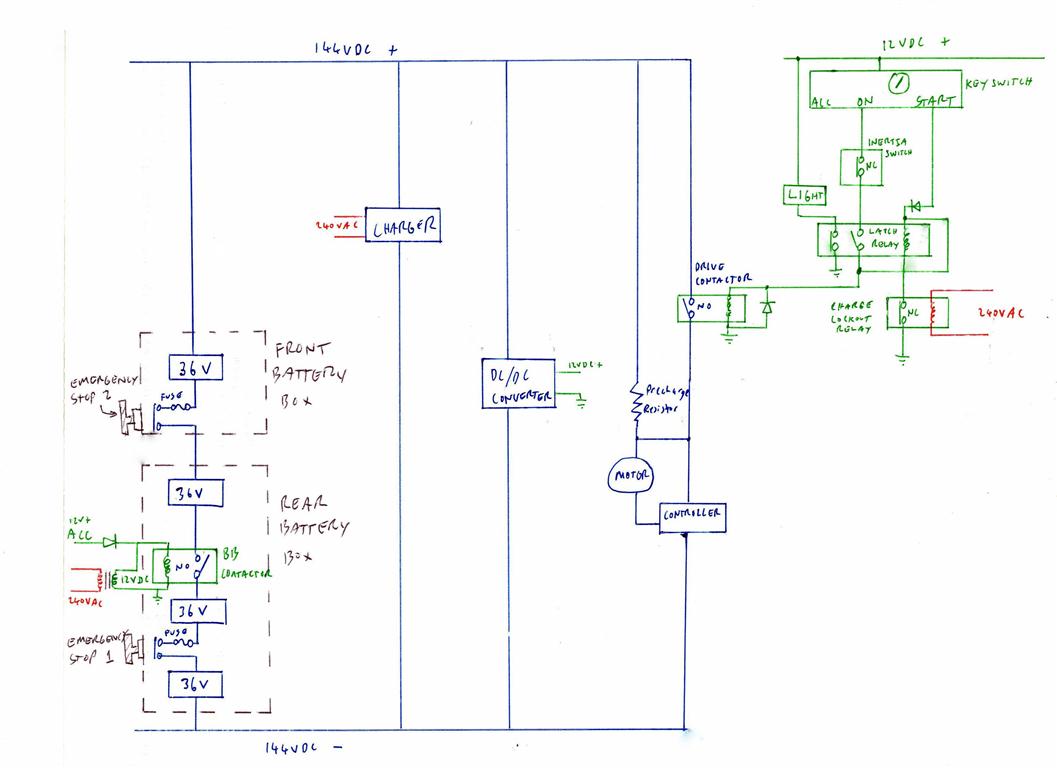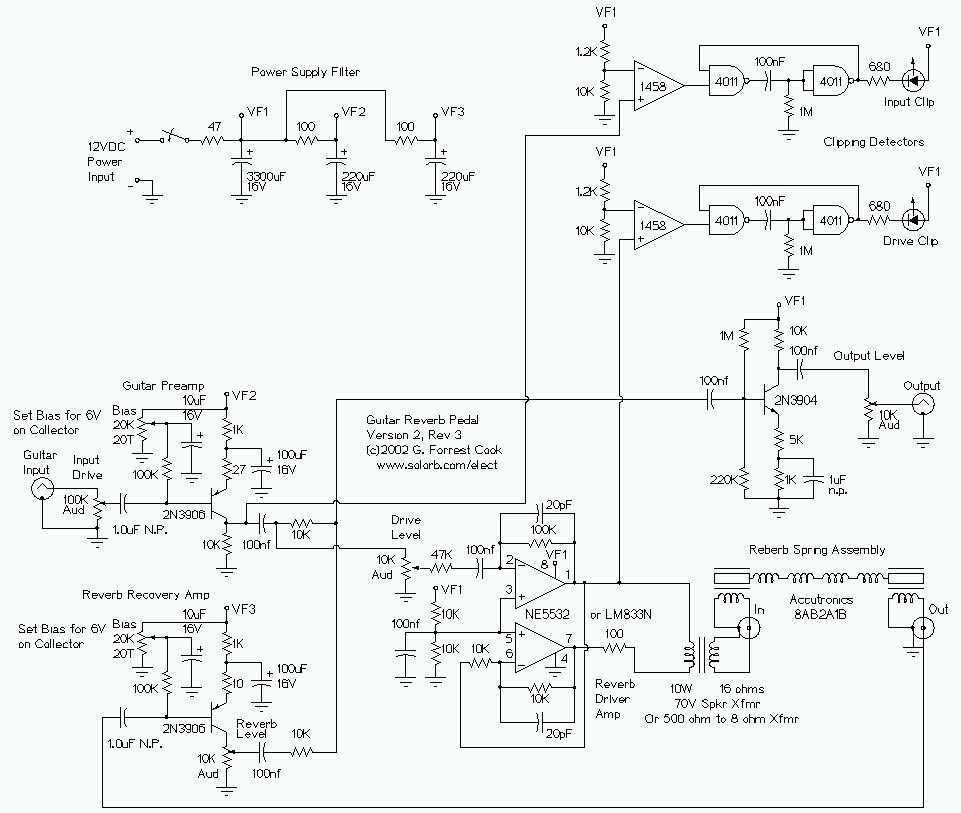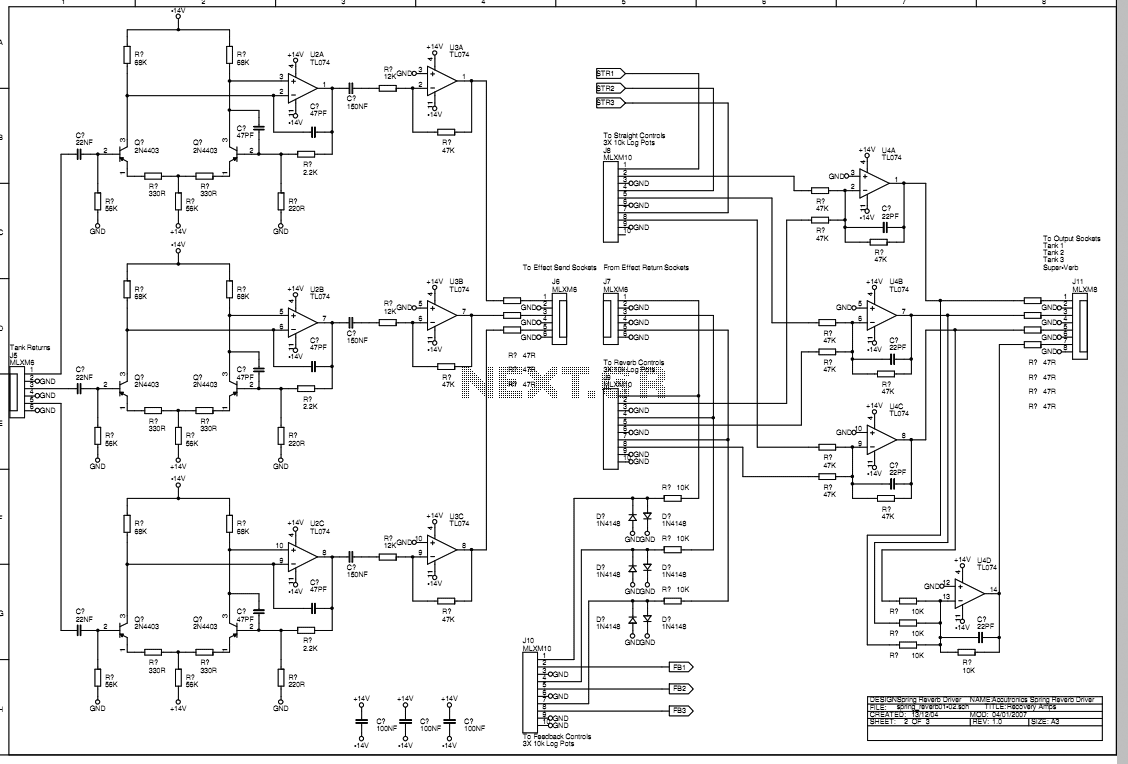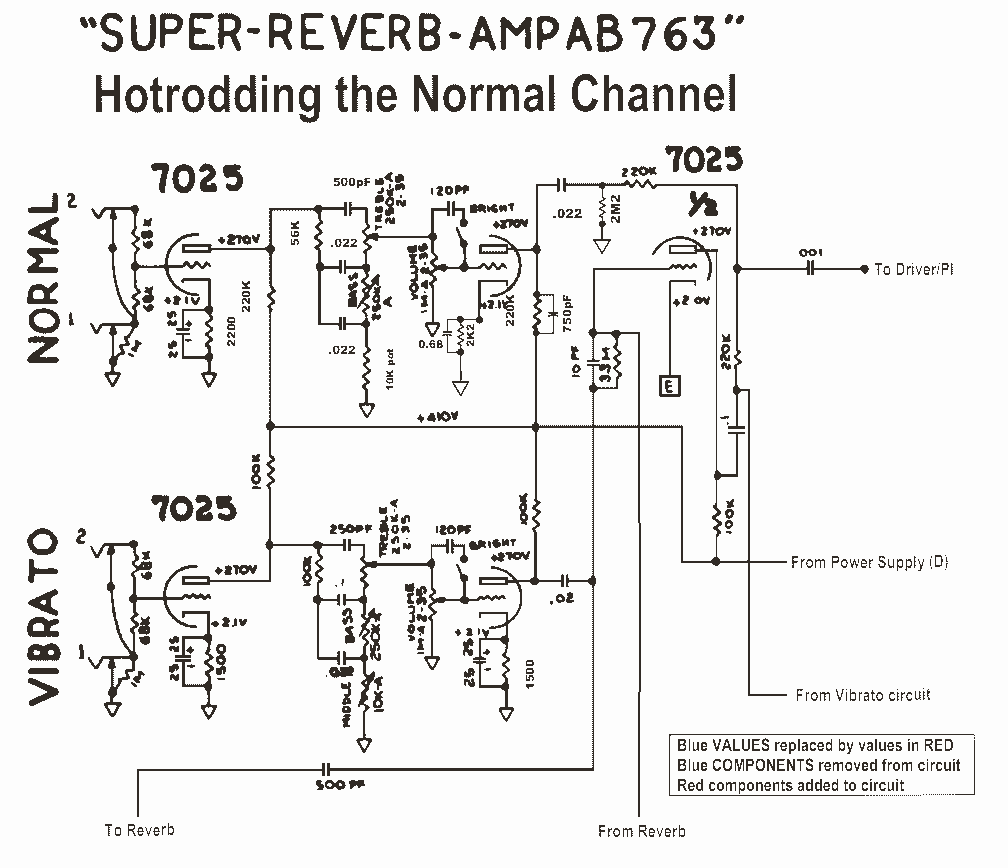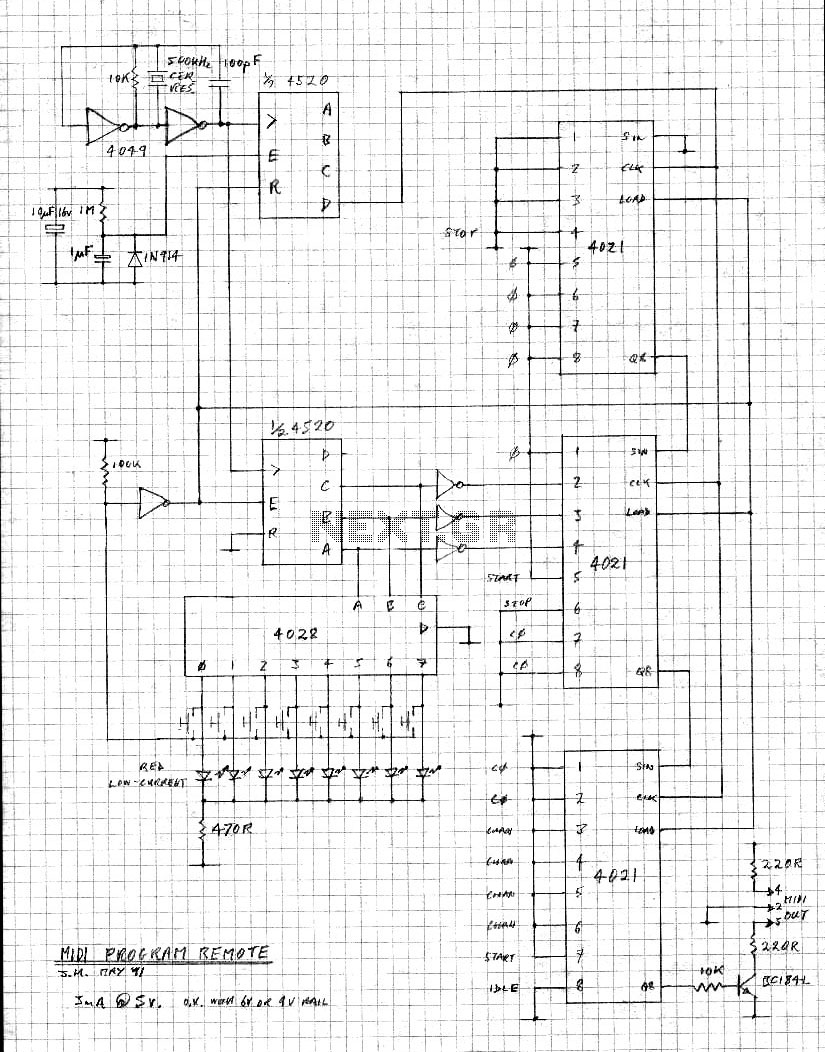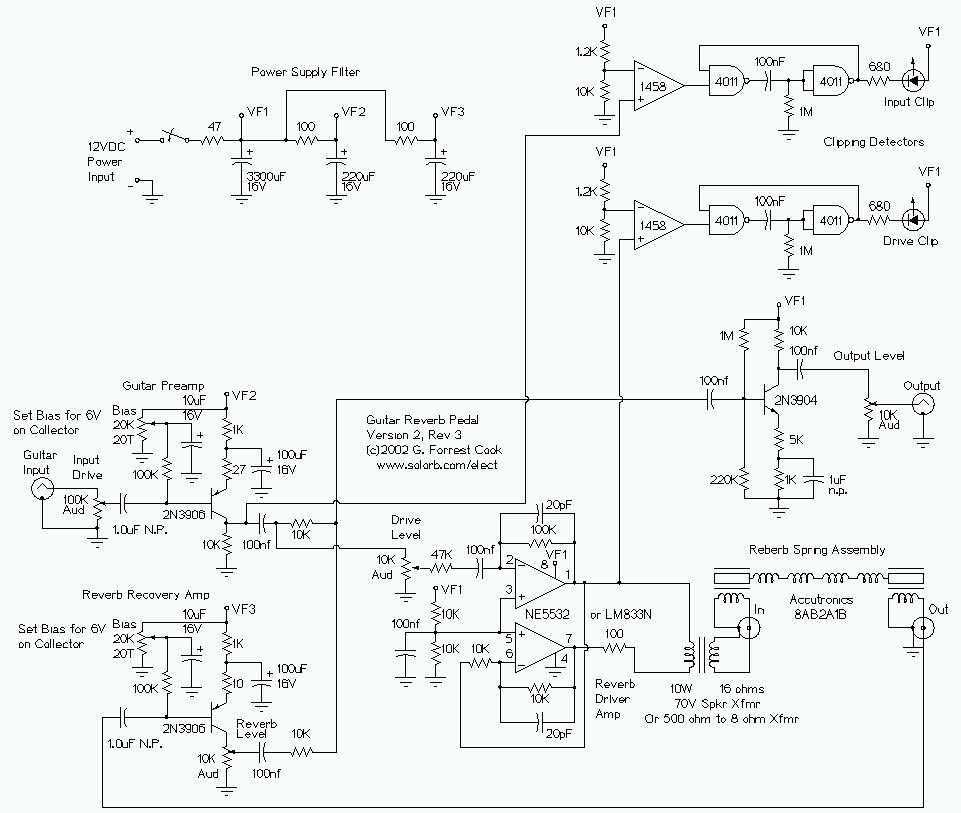
Spring Reverb
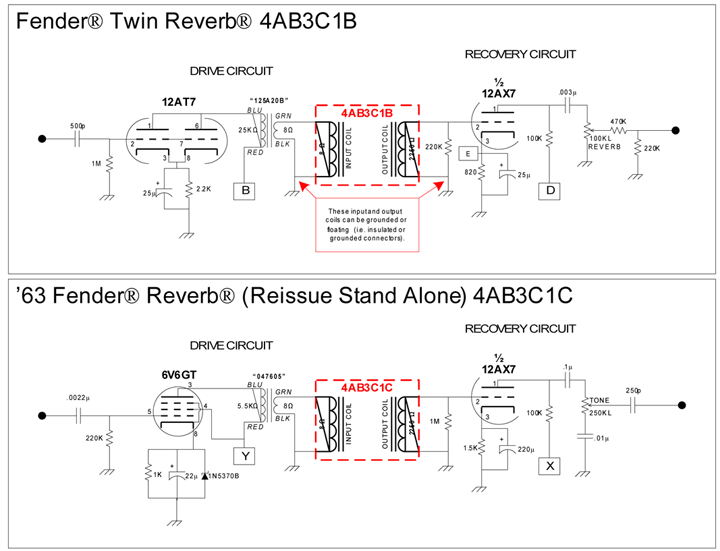
A listener positioned at a distance from a sound source perceives sound as a combination of direct sound and indirect sound that has been reflected off the boundaries of the listening area. These reflections are known as reverberation. Reverb can enhance the perceived sound from a source by adding depth, color, and liveliness. For instance, when inside a large hall and clapping hands once, the time taken for the first reflections to arrive is termed the delay time, typically measured in tens of milliseconds (e.g., 33 ms), and is influenced by the room's volume or the distance of reflective surfaces from the listener. The number and density of reflections increase rapidly over time, becoming cluttered while decreasing in level until they are no longer audible. The time required for sound to diminish in level by 60 dB is referred to as the decay time, usually a few seconds (e.g., 3 s), and it is dependent on the acoustic properties of the reflective surfaces in the space. For example, poured concrete walls reflect more acoustic energy than drywall. Laurens Hammond of Illinois popularized artificial reverberation devices through his church organs in the 1940s and 1950s. The early Hammond organs were marketed to churches based on the principle that organ music benefits from reverberation, while speech can be hindered by it. Consequently, churches were designed to be acoustically dead, necessitating the Hammond organ to have its own artificial reverb. In 1961, reverberation was introduced in the Fender line as a separate item, utilizing a spring unit sourced from Hammond, and it was first included in the Fender amplifier Vibroverb in 1963, subsequently becoming widespread throughout the amplifier line, similar to the earlier incorporation of vibrato/tremolo. An electrical signal applied to the input transducer coil generates an alternating magnetic field, causing the transducer magnets to move. These magnets are mechanically coupled to transmission springs, and the signal is reflected back and forth through the springs, with the delay time determined by each spring's diameter, wire gauge, and length. The moving magnets of the output transducer create an alternating magnetic field that induces an electrical signal in the output transducer coil. Employing multiple transmission springs enhances the reverb characteristics. A listener in a large hall with natural reverberation does not typically stand equidistant from each reflective surface, resulting in reflections from various surfaces with differing delay times. The use of multiple transmission springs with varying delay times simulates a more natural ambiance and improves the overall frequency response, as one spring's response can fill gaps in another's. The selection of decay time should align with the application, as the same decay time that enhances guitar sound may render speech unintelligible. Reverb tanks come in various input and output impedances (measured at 1 kHz) to provide flexibility in designing drive and recovery circuits. The input and output transducers are primarily inductive, with impedance increasing with frequency (inductive reactance). When replacing a reverb tank in an existing amplifier, it is crucial to match the original tank's input and output impedances closely; otherwise, the reverb effect may sound poor or be inaudible. Since DC resistance can be easily measured with an ohmmeter while impedance at 1 kHz cannot, it is sometimes useful to estimate the impedance through DC resistance measurements.
The described reverberation system operates on the principles of sound reflection and acoustic characteristics, allowing for enhanced audio experiences in various environments. The design incorporates input and output transducers that react to electrical signals, enabling the generation of reverberated sound. The use of multiple transmission springs with varying physical properties allows for a more complex and rich reverb effect, simulating the natural acoustics found in large spaces.
In practical applications, the reverberation system must be carefully calibrated to suit the specific acoustic environment and intended use, such as musical performance or speech amplification. The interaction between the input transducer and the transmission springs is critical, as the physical dimensions and materials used directly influence the delay times and overall sound quality.
Moreover, the selection of materials for the reflective surfaces in the listening area plays a significant role in the system's performance. Hard surfaces that reflect sound more effectively can create a more pronounced reverb effect, while softer materials may absorb sound and reduce reverberation.
The importance of impedance matching cannot be overstated, as it ensures optimal signal transfer and sound quality. In cases where reverb tanks are replaced, maintaining similar impedance characteristics is essential to preserve the integrity of the audio output.
This comprehensive understanding of reverberation systems highlights the intricate balance between design, acoustics, and electronic components necessary to achieve the desired auditory experience.A listener standing some distance from a sound source will perceive sound that is actually a combination of direct sound and indirect sound that has been reflected from the boundaries of the listening area. The reflections are referred to as reverberation. Reverb can enhance the perceived sound from a source by adding depth, color and liveliness. Imagine you are inside a large hall and you clap your hands once. The length of time required for the arrival of the very first reflections is called the delay time (usually on the order of tens of milliseconds, e. g. 33 ms) and is related to the volume of the room (or distance of the reflective surfaces from the listener).
The number and density of reflections increases rapidly with time and they become cluttered while simultaneously decreasing in level until they are no longer audible. The length of time required for a sound to decrease in level by 60 dB is called the decay time (usually on the order of a few seconds, e.
g. 3 s) and is related to the acoustical properties of the reflective surfaces in the listening area. For example, poured concrete walls will reflect more (absorb less) acoustic energy than drywall. Laurens Hammond of Illinois popularized the use of artificial reverberation devices through his church organs in the 1940`s and 1950`s. The early (pre-B-3 ®) Hammond ®organs were sold to churches on the principle that organ music is greatly enhanced by reverberation, but the minister`s speech in the church is hampered by reverberation.
Therefore, churches were designed to be acoustically dead, and the Hammond ®organ had to have its own artificial reverberation. "1 [Reverberation] made its debut in the Fender ®line as a separate item, using a spring [unit] bought from Hammond ®, [in] 1961.
It was first incorporated in a Fender ®amplifier with the Vibroverb ®of 1963 and then spread widely throughout the amp line, just as vibrato/tremolo had before it. "2 An electrical signal applied to the input transducer coil generates an alternating magnetic field which moves the transducer magnets.
The magnets are mechanically coupled to transmission springs. The signal is reflected back and forth through the transmission springs with an amount of delay determined by each spring`s diameter, wire gauge and length. The moving magnets of the output transducer generate an alternating magnetic field which induces an electrical signal in the output transducer coil.
The use of multiple transmission springs helps to improve the reverb characteristics. A listener in a large hall with natural reverberation is not usually standing the same distance from each reflective surface. Naturally, there will be reflections from different surfaces having different delay times. The use of multiple transmission springs with different delay times serves to simulate a more natural ambiance, as well as improving the overall frequency response because one spring`s response will fill voids or holes in the other spring`s response.
Decay time should be selected to suit the application. The same reverberation decay time that enhances and adds liveliness to the sound of the guitar can make speech unintelligible. Reverb tanks are supplied in a variety of input and output impedances (measured at 1kHz) to allow for flexibility in designing drive and recovery circuits.
The input and output transducers can be characterized as essentially inductive, with impedance rising with increasing frequency (inductive reactance). When replacing the reverb tank in an existing amplifier design, it is important to match the original tank`s input and output impedances as closely as possible.
The reverb effect will sound poor or inaudible if the impedances are not matched. Because DC resistance can be easily measured with an ohm meter (and Impedance @ 1kHz cannot), it is sometimes useful to estimate the impedance by way of DC resistance. 🔗 External reference
The described reverberation system operates on the principles of sound reflection and acoustic characteristics, allowing for enhanced audio experiences in various environments. The design incorporates input and output transducers that react to electrical signals, enabling the generation of reverberated sound. The use of multiple transmission springs with varying physical properties allows for a more complex and rich reverb effect, simulating the natural acoustics found in large spaces.
In practical applications, the reverberation system must be carefully calibrated to suit the specific acoustic environment and intended use, such as musical performance or speech amplification. The interaction between the input transducer and the transmission springs is critical, as the physical dimensions and materials used directly influence the delay times and overall sound quality.
Moreover, the selection of materials for the reflective surfaces in the listening area plays a significant role in the system's performance. Hard surfaces that reflect sound more effectively can create a more pronounced reverb effect, while softer materials may absorb sound and reduce reverberation.
The importance of impedance matching cannot be overstated, as it ensures optimal signal transfer and sound quality. In cases where reverb tanks are replaced, maintaining similar impedance characteristics is essential to preserve the integrity of the audio output.
This comprehensive understanding of reverberation systems highlights the intricate balance between design, acoustics, and electronic components necessary to achieve the desired auditory experience.A listener standing some distance from a sound source will perceive sound that is actually a combination of direct sound and indirect sound that has been reflected from the boundaries of the listening area. The reflections are referred to as reverberation. Reverb can enhance the perceived sound from a source by adding depth, color and liveliness. Imagine you are inside a large hall and you clap your hands once. The length of time required for the arrival of the very first reflections is called the delay time (usually on the order of tens of milliseconds, e. g. 33 ms) and is related to the volume of the room (or distance of the reflective surfaces from the listener).
The number and density of reflections increases rapidly with time and they become cluttered while simultaneously decreasing in level until they are no longer audible. The length of time required for a sound to decrease in level by 60 dB is called the decay time (usually on the order of a few seconds, e.
g. 3 s) and is related to the acoustical properties of the reflective surfaces in the listening area. For example, poured concrete walls will reflect more (absorb less) acoustic energy than drywall. Laurens Hammond of Illinois popularized the use of artificial reverberation devices through his church organs in the 1940`s and 1950`s. The early (pre-B-3 ®) Hammond ®organs were sold to churches on the principle that organ music is greatly enhanced by reverberation, but the minister`s speech in the church is hampered by reverberation.
Therefore, churches were designed to be acoustically dead, and the Hammond ®organ had to have its own artificial reverberation. "1 [Reverberation] made its debut in the Fender ®line as a separate item, using a spring [unit] bought from Hammond ®, [in] 1961.
It was first incorporated in a Fender ®amplifier with the Vibroverb ®of 1963 and then spread widely throughout the amp line, just as vibrato/tremolo had before it. "2 An electrical signal applied to the input transducer coil generates an alternating magnetic field which moves the transducer magnets.
The magnets are mechanically coupled to transmission springs. The signal is reflected back and forth through the transmission springs with an amount of delay determined by each spring`s diameter, wire gauge and length. The moving magnets of the output transducer generate an alternating magnetic field which induces an electrical signal in the output transducer coil.
The use of multiple transmission springs helps to improve the reverb characteristics. A listener in a large hall with natural reverberation is not usually standing the same distance from each reflective surface. Naturally, there will be reflections from different surfaces having different delay times. The use of multiple transmission springs with different delay times serves to simulate a more natural ambiance, as well as improving the overall frequency response because one spring`s response will fill voids or holes in the other spring`s response.
Decay time should be selected to suit the application. The same reverberation decay time that enhances and adds liveliness to the sound of the guitar can make speech unintelligible. Reverb tanks are supplied in a variety of input and output impedances (measured at 1kHz) to allow for flexibility in designing drive and recovery circuits.
The input and output transducers can be characterized as essentially inductive, with impedance rising with increasing frequency (inductive reactance). When replacing the reverb tank in an existing amplifier design, it is important to match the original tank`s input and output impedances as closely as possible.
The reverb effect will sound poor or inaudible if the impedances are not matched. Because DC resistance can be easily measured with an ohm meter (and Impedance @ 1kHz cannot), it is sometimes useful to estimate the impedance by way of DC resistance. 🔗 External reference
Warning: include(partials/cookie-banner.php): Failed to open stream: Permission denied in /var/www/html/nextgr/view-circuit.php on line 713
Warning: include(): Failed opening 'partials/cookie-banner.php' for inclusion (include_path='.:/usr/share/php') in /var/www/html/nextgr/view-circuit.php on line 713
